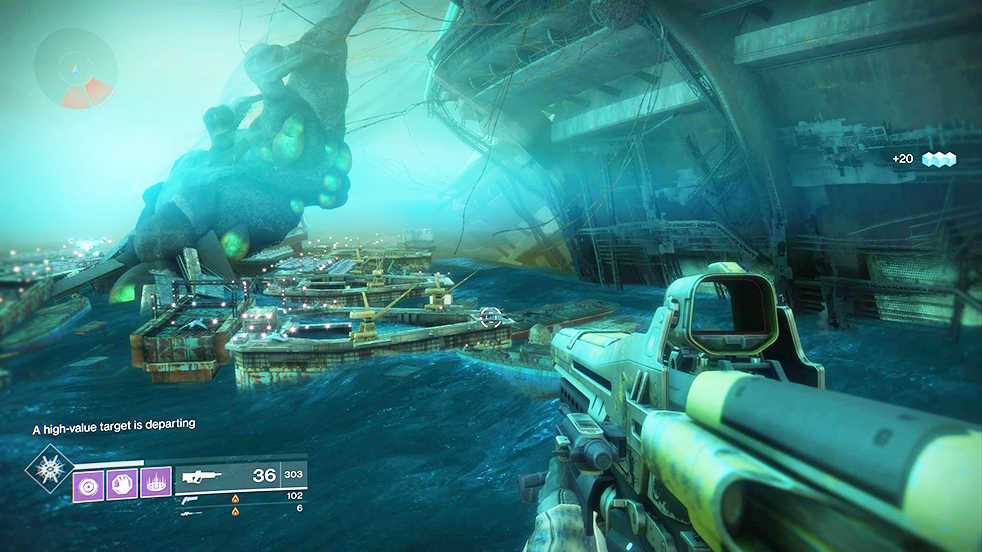The release of Bungie’s Destiny in 2014 was something of a cultural phenomenon. Rarely does a game generate that level of hype; Bungie’s reputation for creating the lauded Halo franchise put Destiny in the spotlight from the second it was announced.
As details about the game began to slowly trickle out, people following Destiny began to dream of a Halo-esque multiplayer RPG that would turn the genre on its head. Bungie tacked on a promising gameplay trailer at 2013’s E3 conference and essentially laid claim on $60 from everyone watching. Destiny was going to be the game to buy in 2014.
That September, stores across the globe moved copies of Destiny like it was the McRib. It easily became the largest new franchise launch of all time. Tech’s streets seemed empty: its students were packed into dorm rooms and fraternity houses to experience this new game. It was beautiful, it was novel — and, after a week — it was stale.
Although Destiny went on to become one of the most popular games of both the last and the current console generations, it came from unexpectedly humble beginnings. Upon release the game offered little beyond its repetitive story missions and competitive multiplayer mode. After a single playthrough, many underwhelmed players put the game away and never returned.
Only after a series of post-release content updates and expansions did Destiny find its stride. By the end of its lifespan, the game had become one of the biggest and most robust time-sinks in the gaming world.
The announcement of a sequel had players wondering what Destiny 2 could bring to the table that another one of the original’s game-transforming expansions did not. Would Bungie learn from its mistakes and launch a fully fleshed-out game rather than a barebones foundation?
Bungie undoubtedly handled the launch of Destiny 2 differently than the original. Complaints that plagued the first game, such as nitpicks about end-game content and creating a “full” game world, have been virtually non-existent since the sequel’s release.
The open-world mechanic has been completely redone to allow for a more cohesive experience, allowing each area to serve as a “hub” of sorts in which players take on missions and do sidequests without constantly returning to their ship.
The world has been fleshed out with dozens of hidden chests, secret boss fights and team-based public events to keep players occupied in between main story missions or competitive matches. Free-roaming through the game’s planets and moons — a boring and tedious aspect of the original — no longer feels like a chore.
Bungie filled the game to the brim with things to do, and the bad taste that the original Destiny left in players’ mouths is all but nonexistent.
Destiny 2 marks the franchise’s first appearance on PC, though mouse-and-keyboard players will have to wait a few more weeks to get their hands on it. The PS4 and XBox One releases are both optimized for 4K, so graphically the disparity between console and PC will not be as big an issue.
The game’s environments look stunning in 4K, and the wide variety of weapons and abilities all take advantage of the improved hardware of this console generation. Composer Michael Salvatori, famous for the iconic Halo soundtracks and the original Destiny, returned to provide the game’s stellar score.
The original game’s competitive multiplayer mode, referred to in-game as the Crucible, gave players the gameplay they had craved since the days of Halo 3. The Crucible is back this time around with seemingly balanced maps and gameplay features.
While there are currently few player-vs-player options, future updates promise to bring back fan-favorites like Trials of Osiris. The Crucible is quite fun; doing battle with other guardians is tense and rewarding. Much time can also be sunk into the main quest missions themselves.
Destiny caught flak for its convoluted and often repetitive story, and one of the sequel’s biggest strengths is a more tightly-focused and accessible plot. The politics of intergalactic warfare left players of the original bored, while the endless menagerie of characters made it hard to become invested in the game’s overarching conflict.
Destiny 2 sifts all of this down into the essentials, bringing back popular characters from the original and framing the story as a
revenge tale rather than a lore-heavy snoozefest.
The game’s most glaring issue is barely an issue at all, but it still gives reason to worry about the future of the franchise. A new marketplace, called the Eververse was added to the game that uses real-world currency to buy items in-game.
Many popular games have adopted a micro-transaction model, simply because it makes them more money. If the Eververse proves to be popular, Bungie could be tempted to monetize more parts of the game in an attempt to milk players for even more cash. It i s 2017: at this point, our udders are tired.
If a game’s biggest flaw is an unlikely hypothetical future situation that relates even tangentially to the word “udders,” it is a
great game sure to engage former players and earn new ones.
Bungie kept everything good from the original and refined almost every aspect of the gameplay to create a fun, content-filled experience.
There is no doubt that Destiny 2 has some real staying power; guardians will be doing battle throughout the virtual solar system for years to come.
